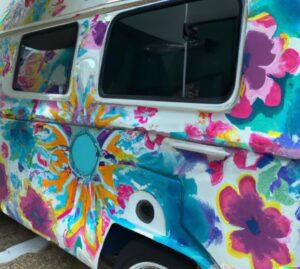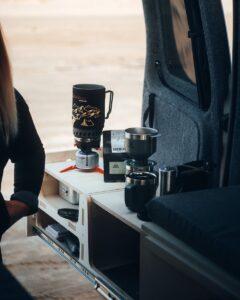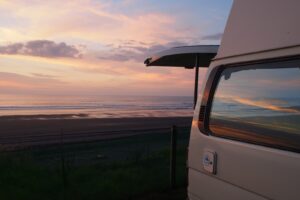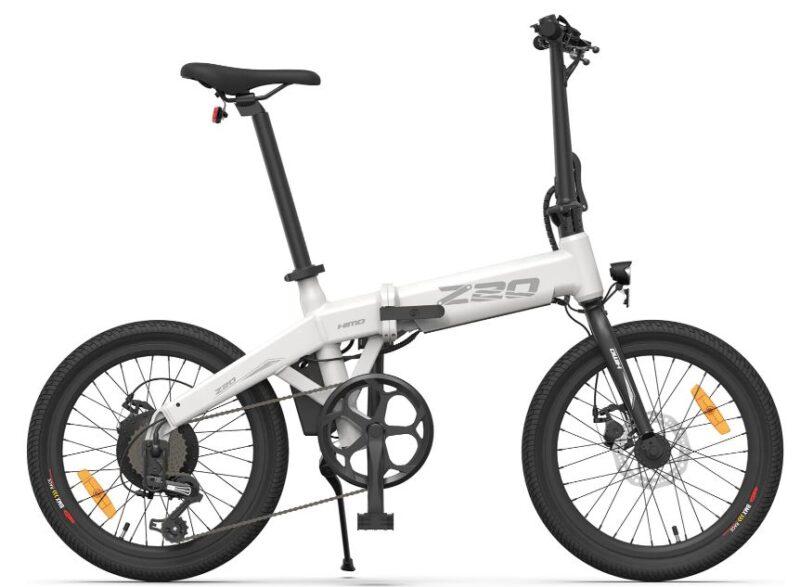
10 Tips to Consider When Building your Own Camper Van
10 Tips to Consider When Building your Own Camper Van
Plan out the layout and design of your campervan carefully

There are a few key steps to planning out the layout and design of your campervan:
- Measure the dimensions of your van carefully, and create a scale model or floor plan to help you visualize how the space will be used.
- Consider the way you will use the campervan, and make a list of your must-have features and amenities, such as a bed, kitchen, seating area, storage, and bathroom.
- Think about the layout and flow of the space, and try to create a functional and efficient design that maximizes the use of available space.
- Consider the placement of key features, such as the bed, kitchen, and storage areas, and try to balance the need for privacy and separation with the desire for an open and social atmosphere.
- Don’t forget to include features that will make your campervan comfortable and enjoyable to use, such as windows, lighting, and ventilation.
- Use design tools, such as 3D modeling software or cardboard cutouts, to help you visualize and plan out the layout and design of your campervan.
- Be flexible and open to making changes as you go along, as the design process can be an iterative one and you may discover new needs or preferences as you work.
Choose high-quality materials
When building a campervan, it’s important to choose materials that are durable, weather-resistant, and suitable for use in a mobile home. Some materials to consider include:
- Waterproof and weather-resistant fabrics for upholstery, window coverings, and other surfaces that may be exposed to the elements.
- Sturdy and water-resistant cabinets and countertops, such as those made from plywood or composite materials to provide storage and workspace.
- High-quality mounting hardware, such as screws, bolts, and brackets, to securely fasten cabinets, countertops, and other fixtures to the van walls and floor.
- Insulation materials, such as foam board or fiberglass to keep the campervan warm in the winter and cool in the summer.
- Ventilation systems, such as roof vents or fans, to help circulate air and reduce condensation.
- Durable and slip-resistant flooring materials, such as vinyl or linoleum, to withstand wear and tear and provide a safe surface to walk on.
- Quality appliances and equipment, such as a refrigerator, stove, and water heater, to provide the amenities you need while on the road.
- Hardware and fixtures, such as door handles, locks, and sink taps, to complete the campervan and make it feel like home.
Install appropriate electrical and plumbing systems
When building a campervan, there are a few key electrical and plumbing systems you will need to install:
- A reliable power source, such as a battery or generator, provides electricity for lighting, appliances, and other devices.
- Lighting systems, including interior and exterior lights, as well as task lighting for areas like the kitchen and bathroom.
- Electrical outlets and switches, to provide power for devices and appliances and allow you to control the flow of electricity.
- A water supply system, including a freshwater tank, pump, and faucets, provides water for cooking, cleaning, and personal hygiene.
- A waste water tank and plumbing system, to manage and dispose of grey and black water from the sink, shower, and toilet.
- A heating and cooling system, if needed, to keep the campervan comfortable in all types of weather.
- Appliances and equipment, such as a refrigerator, stove, and hot water heater, to provide the amenities you need while on the road.
- Safety features, such as smoke and carbon monoxide detectors, to protect you and your campervan from hazards.
Consider the storage needs of your campervan
When designing the storage space in your campervan, here are a few things to consider:
- How much gear and personal belongings do you need to store, and what types of storage solutions will be most effective for your needs?
- The size and layout of your campervan, and how you can use the available space most efficiently.
- The weight and balance of your campervan (this is a topic that many people overlook!), and how your storage solutions will affect the overall weight distribution (important).
- The accessibility and convenience of your storage areas, and how easily you can reach and retrieve your items.
- The durability and weather-resistance of your storage solutions, and how well they will hold up to the rigors of life on the road.
- The style and appearance of your storage solutions, and how they will fit in with the overall design of your campervan.
- The cost and maintenance of your storage solutions, and whether you are willing to invest in more expensive but longer-lasting options.
- Any specific storage needs you may have, such as for items like bikes, skis, or surfboards that may require special carriers or racks.
Install comfortable and functional seating and sleeping areas

When installing seating and sleeping areas in your campervan, here are a few things to consider:
- The size and layout of your campervan, and how much space you have available for seating and sleeping.
- The number of people who will be using the campervan, and how much seating and sleeping capacity you need.
- The types of activities you will be doing in your campervan, and whether you need seating and sleeping areas that can be easily converted for different purposes.
- The comfort and support of the seating and sleeping areas, and whether you need cushions, mattresses, or other padding to make them more comfortable.
- The durability and wear resistance of the seating and sleeping areas, and how well they will hold up to frequent use and cleaning.
- The appearance and style of the seating and sleeping areas, and how they will fit in with the overall design of your campervan.
- The cost and maintenance of the seating and sleeping areas, and whether you are willing to invest in more expensive but longer-lasting options.
- Any specific seating or sleeping needs you may have, such as for children or pets, and how these can be accommodated in the design of your campervan.
Think about how you will use your campervan
There are a few key things to think about when determining how you will use your campervan:
- The type of travel you will be doing, and whether you will be staying in one place for an extended period of time or moving frequently.
- The number of people who will be using the campervan, and whether you will need space for sleeping, cooking, and socializing.
- The types of activities you will be doing in your campervan, and whether you will need space and equipment for hobbies, sports, or other pursuits.
- The climate and weather conditions you will be experiencing, and whether you will need specialized systems for heating, cooling, or ventilation.
- The duration of your trips, and whether you will need to be self-sufficient for extended periods of time, or whether you will have access to amenities like showers and laundromats.
- The budget and resources you have available, and what you can afford in terms of appliances, equipment, and systems.
- Your personal preferences and lifestyle, and what type of campervan will best suit your needs and desires.
Use insulation and ventilation

There are a few key ways to use insulation and ventilation in your campervan to improve comfort and efficiency:
- Use insulation materials, such as foam board or fiberglass, to reduce heat loss in the winter and heat gain in the summer, and to minimize noise and vibration.
- Install insulation in key areas, such as the walls, floors, and ceiling, to maximize its effectiveness.
- Use weather stripping and sealing materials to seal gaps and prevent drafts, and to keep out dust, dirt, and pests.
- Install ventilation systems, such as roof vents or fans, to help circulate air and reduce condensation.
- Place ventilation openings in strategic locations, such as near the top of the walls or the ceiling, to allow warm air to rise and escape.
- Use window coverings, such as shades or blinds, to block out the sun and reduce heat gain in the summer, and to retain heat in the winter.
- Open windows and doors to allow air to circulate and help cool the campervan down on hot days.
- Run ventilation systems and fans when cooking or using the bathroom to help remove excess moisture and odors.
Make sure your campervan is safe and roadworthy

There are a few key things you can do to make sure your campervan is safe and roadworthy:
- Regularly maintain and inspect all systems and components, including the brakes, tires, engine, and electrical and plumbing systems.
- Follow all applicable laws and regulations, such as those related to vehicle registration, licensing, and insurance.
- Use high-quality, road-tested materials and equipment, and follow the manufacturer’s recommendations for installation and use.
- Secure all loose items and equipment, and make sure they are properly stored and fastened to prevent them from shifting or falling while driving.
- Keep your campervan clean and well-organized, and remove any unnecessary items that may add weight or clutter.
- Use caution when driving and operating your campervan, and always follow safe driving practices and techniques.
- Follow the rules of the road, and be considerate of other drivers and pedestrians.
- Have a plan in case of emergencies, and make sure you have a first aid kit, tools, and supplies on hand in case of breakdowns or accidents.
Keep your campervan organized

A few tips for keeping your campervan tidy and organized:
- Designate specific storage areas for different types of items, and use containers or organizers to keep things in their place.
- Use space-saving furniture and multi-purpose items, such as fold-down tables or under-seat storage bins, to maximize the use of available space.
- Keep frequently used items within easy reach, and store less frequently used items in more out-of-the-way locations.
- Use hooks, straps, or bungee cords to secure items that might shift or fall while driving.
- Regularly clean and declutter your campervan, and get rid of items that you no longer need or use.
- Use plastic bins, bags, or containers to protect items from dust, moisture, and pests.
- Keep surfaces clear and free of clutter, and use covers or placemats to protect them from spills and stains.
- Use odor-eliminating products, such as air fresheners or baking soda, to keep your campervan smelling fresh and clean.
Have fun and be creative when building your campervan

Here are a few ways to have fun and be creative when building your campervan:
- Personalize the design of your campervan to reflect your personality and style, and use colorful or unique materials and accents to make it stand out.
- Experiment with different layouts and design configurations, and be open to making changes as you go along.
- Include features and amenities that will make your campervan comfortable and enjoyable to use, such as cozy seating areas, outdoor spaces, or entertainment systems.
- Get creative with your storage solutions, and use unexpected or unconventional items, such as baskets, bags, or bins, to keep your gear organized.
- Use your campervan as an opportunity to try out new hobbies or activities, and equip it with the tools and equipment you need to pursue your passions.
- Invite friends or family members to join in the building process, and make it a fun and social experience.
- Take your time and enjoy the process, and don’t worry about making everything perfect or meeting someone else’s standards.
- Have fun and be proud of your creation, and share your campervan with others through social media or online communities.
Our Facebook Group would love to see you build and design as you progress in your build. Share your ideas with our community and ask for any tips or tricks that would improve your van.
Our Store, Johnny’s Backyard has over 100 items that will improve your campervan build and make it more comfortable. Some of these items are on longer delivery times but this will encourage you not to rush your build. This will lead to many incomplete projects that while they are functional are not finished
Above all Have Fun!
10 Tips to Consider When Building your Own Camper Van
Shop YouTube Channel youtube.com/@johnnysbackyard/?sub_confirmation=1
Why not join our Facebook Group Motorhome Touring Scotland? https://www.facebook.com/motorhometouringscotland
Sign up for Johnny’s Back Yard online Store for Motorhome & Caravan Accessories Newsletter and we will let you know when new products are released. Newsletter link: http://eepurl.com/hND3Ir
Website Store https://www.johnnysbackyard.co.uk
Check out the Useful Links Page for more goodies https://johnnysbackyard.co.uk/useful-links-and-things/recommended-campsites/
Support the shop https://www.paypal.com/donate/?hosted_button_id=MZ4U3STTL4YV6
YouTube https://www.youtube.com/channel/UCMO8bf5oorGtPxHGCPzg6bw/?sub_confirmation=1
Twitter https://twitter.com/MotorhomeandC
Instagram https://www.instagram.com/johnnyburr3
Facebook https://www.facebook.com/groups/179155772711444
Pinterest https://www.pinterest.co.uk/johnnyburr3
Buy Me A Coffee https://www.buymeacoffee.com/johnnyburr
10 Tips to Consider When Building your Own Camper Van





















